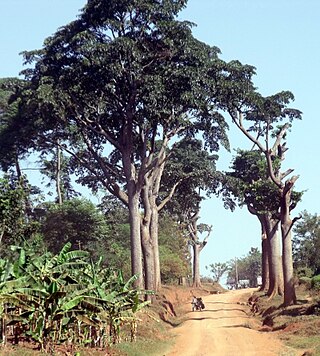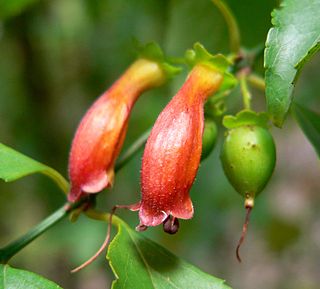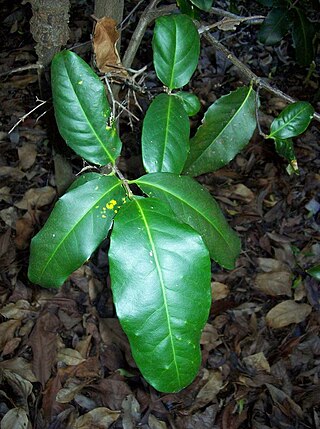
Pachypodium lealii, the bottle tree, is a species of plant included in the genusPachypodium. The scientific name derives from the 19th century Portuguese geologist Fernando da Costa Leal, who described the bottle tree during an exploration in southern Angola.

Diospyros mespiliformis, the jackalberry, is a large dioecious evergreen tree found mostly in the savannas of Africa. Jackals are fond of the fruit, hence the common names. It is a member of the family Ebenaceae, and is related to the true ebony and edible persimmon.

Spirostachys africana is a medium-sized deciduous tree with a straight, clear trunk, occurring in the warmer parts of Southern Africa. Its wood is known as tamboti, tambotie, tambootie or tambuti.

Xanthorrhoea australis, the grass tree or austral grasstree, is an Australian plant. It is the most commonly seen species of the genus Xanthorrhoea. Its trunk can grow up to several metres tall and is often branched. In certain Aboriginal languages, it is called bukkup, baggup or kawee.

Mimusops zeyheri is a medium-sized evergreen tree belonging to the family Sapotaceae and widely distributed in rocky places from the east coast of southern Africa, inland and northwards to tropical Africa. It is commonly known as milkwood or Transvaal red milkwood. It is closely related to Mimusops obovata and M. caffra, both of which are South African trees.

Milicia excelsa is a tree species from the genus Milicia of the family Moraceae. Distributed across tropical Central Africa, it is one of two species yielding timber commonly known as African teak, iroko, intule, kambala, moreira, mvule, odum and tule.

Diploglottis australis, known as the native tamarind, is a well known rainforest tree of eastern Australia. It is easily identified by the large sausage shaped leaflets.

Brabejum is a genus of a single species of large evergreen tree, Brabejum stellatifolium in the family Proteaceae, commonly called wild almond, bitter almond or ghoeboontjie. It is restricted in the wild to South Africa's Western Cape province, where it grows in thickets along the banks of streams. The plant is of botanical interest as being Africa's only member of the large grevilleoid subfamily. It is a bushy small tree with branches widely at ground level and numerous erect vigorous stems. Leaves grow up to 6 in (15 cm) long, narrow and bluntly toothed, appear at intervals along the branches, mostly in whorls of 6. In summer, the plant bears white flowers densely crowded on spikes arising from rusty buds at the leaf axils. The fruits to 2 in (5 cm) long, magenta to reddish brown, similar to an almond, appear in autumn. The nut is too bitter to eat; however, in earlier times it was boiled, roasted, and ground to make a "coffee" drink.

Eucalyptus urophylla, commonly known as Timor white gum, Timor mountain gum, popo or ampupu, is a species of eucalypt native to islands of the Indonesian Archipelago and Timor.

Celtis africana, the white stinkwood, is a deciduous tree in the family Cannabaceae. Its habit ranges from a tall tree in forest to a medium-sized tree in bushveld and open country, and a shrub on rocky soil. It occurs in Yemen and over large parts of Africa south of the Sahara. It is a common tree in the south and east of southern Africa, where the odour given off by freshly-cut green timber is similar to that of Ocotea bullata or black stinkwood.

Cupaniopsis baileyana is a species of flowering tree in the soapberry family. It is native to eastern Australia. Common names include White Tamarind and Toothed Tuckeroo. The species name honours the botanist F.M.Bailey.

Halleria lucida is a small, attractive, evergreen tree that is indigenous to Southern Africa. It is increasingly grown as an ornamental tree in African gardens.

Corynocarpus rupestris, commonly known as the Glenugie karaka, is a rainforest tree found in eastern Australia. It is a rare plant with a ROTAP rating of 2VC-t. There are two sub-species; arborescens is a small hairless shrub or tree up to 13 metres tall with a stem diameter up to 40 cm (16 in), and sub-species rupestris grows only to 6 metres, with a stem diameter up to 17 cm (6.7 in).

Laurus novocanariensis is a large shrub or tree with aromatic, shiny dark-green foliage. belonging to the evergreen tree genus Laurus of the laurel family, Lauraceae. The genus includes three species, whose diagnostic key characters often overlap. Under favorable conditions it is an impressive tree of 3 to 20 m. tall. It is native of rich soils in the cloud zone of always moist spots in subtropical climate with a high air-humidity, on the Canary and Madeira islands.

Tabernaemontana ventricosa is a plant in the family Apocynaceae. It grows as a shrub or small tree up to 15 metres (50 ft) tall, with a trunk diameter of up to 30 centimetres (12 in) and has white sap. Leaves are paired and crowded near the ends of branches. They are oblong, leathery and a glossy dark green. Flowers are fragrant with white, somewhat twisted lobes, often with a pale yellow center and are set in small clusters at the ends of branches. The fruit is dark green, set in spreading pairs of ellipsoids or oval, beaked pods, up to 10 centimetres (4 in) in diameter. Its habitat is forests from sea level to 1,850 metres (6,000 ft) altitude. In Zimbabwe, it is usually found as part of the understorey of evergreen forests. Local medicinal uses include the treatment of wounds, fever and hypertension. The plant is native to tropical central and southern Africa.

Englerophytum natalense, the silver-leaf milkplum, is a medium-sized, evergreen tree that occurs along forested escarpments from East Africa to South Africa. The leaves are alternately arranged or spiralled, and to some extent crowded near the ends of branches. They are glossy green to greyish green above and covered in silvery hairs below. The stem is straight and the bark smooth. Young branches are covered with dense brownish hairs. The plant contains a milky latex.

Englerophytum is a group of trees in the family Sapotaceae described as a genus in 1914.

Euclea crispa, commonly known as the blue guarri, is an Afrotropical plant species of the family Ebenaceae. The hardy and evergreen plants may form a dense stand of shrubs, or grow to tree size. It is widespread and common in the interior regions of southern Africa, and occurs northward to the tropics. Though some are present near the South African south and east coasts, they generally occur at middle to high altitudes. It is readily recognizable from its much-branched structure and dull bluish foliage colour. Those bearing lanceolate leaves may however resemble the Wild olive, another common species of the interior plateaus.

Eucalyptus occidentalis, commonly known as the flat topped yate or the swamp yate, is a tree that is native to Western Australia. The Noongar names for the tree are Mo or Yundill.
Ficus amplissima, also known as the Indian bat tree, Indian bat fig, Pimpri, Pipri (Piparee), Pipali or Bilibasari mara is a tree species of flowering plants that belongs to Moraceae, the fig or mulberry family. It is native to Central and southern Peninsular India, Sri Lanka and Maldives, having a significant distribution throughout Western Ghats of India. It is most commonly planted to provide shade in coffee plantations due to its dense and wide foliage. The ripened figs attract many birds, especially during the spring.























